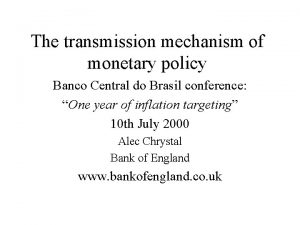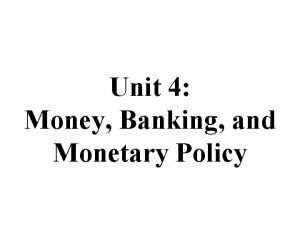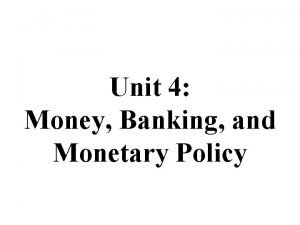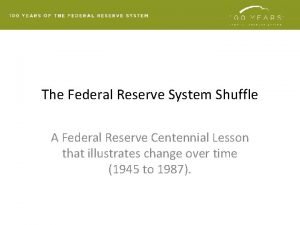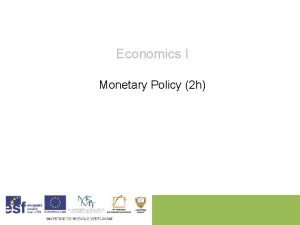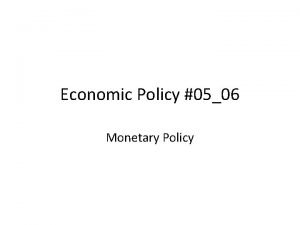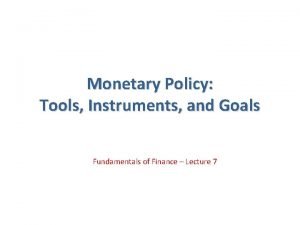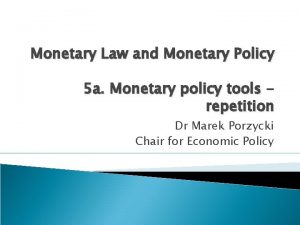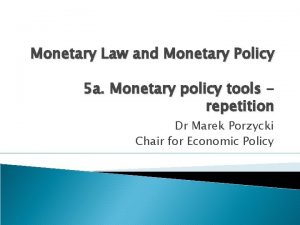chapter 25 Transmission Mechanisms of Monetary Policy The












- Slides: 12

chapter 25 Transmission Mechanisms of Monetary Policy: The Evidence

Two Types of Empirical Evidence Structural Model Evidence M i I Y Reduced Form Evidence M ? Y Structural Model Evidence Advantages: 1. Understand causation because more information on link between M and Y 2. Knowing how M affects Y helps prediction 3. Can predict effects of institutional changes that change link from M to Y Disadvantages: 1. Structural model may be wrong, negating all advantages Copyright © 2002 Pearson Education Canada Inc. 25 - 2

Reduced Form Evidence Advantages: 1. No restrictions on how M affects Y: better able to find link from M to Y Disadvantages: 1. Reverse causation possible 2. Third factor may produce correlation of M and Y Copyright © 2002 Pearson Education Canada Inc. 25 - 3

Early Keynesian Evidence: 1. Great Depression: i on T-bonds to low levels monetary policy was “easy” 2. No statistical link from i to I 3. Surveys: no link from i to I Objections to Keynesian evidence Problems with structural model 1. i on T-bonds not representative during Depression: i very high on low-grade bonds 2. ir more relevant than i: ir high during Depression: Figure 25 -1 3. Ms during Depression (Friedman and Schwartz): money “tight” 4. Wrong structural model to look at link of i and I, should look at ir and I: evidence in 1 and 2 suspect Copyright © 2002 Pearson Education Canada Inc. 25 - 4

Real and Nominal Interest Rates Figure 25 -1 Copyright © 2002 Pearson Education Canada Inc. 25 - 5

Early Monetarist Evidence Monetarist evidence is reduced form Timing Evidence (Friedman and Schwartz) 1. Peak in Ms growth 16 months before peak in Y on average 2. Lag is variable Criticisms: 1. Uses principle: Post hoc, ergo propter hoc 2. Principle only valid if first event is exogenous: i. e. , if have controlled experiment 3. Hypothetical example (Fig 25 -2): Reverse causation from Y to M and yet Ms growth leads Y Copyright © 2002 Pearson Education Canada Inc. 25 - 6

Hypothetical Example in Which M/M leads Y Figure 25 -2 Copyright © 2002 Pearson Education Canada Inc. 25 - 7

Statistical Evidence Horse race: correlation of A vs M with Y; Friedman and Meiselman, M wins Criticisms: 1. Reverse causation from Y to M, or third factor driving M and Y are possible 2. Keynesian model too simple, unfair handicap 3. A measure poorly constructed Postmortem with different measures of A: no clear-cut victory Copyright © 2002 Pearson Education Canada Inc. 25 - 8

Historical Evidence Friedman and Schwartz: Monetary History of the U. S. 1. Important as criticism of Keynesian evidence on Great Depression 2. Documents timing evidence More convincing than other monetarist evidence: Episodes are almost like “controlled experiments” 1. Post hoc, ergo propter hoc applies 2. History allows ruling out of reverse causation and third factor: e. g. , 1936– 37 rise in reserve requirements in the U. S. and the 1937 -38 U. S. recession Copyright © 2002 Pearson Education Canada Inc. 25 - 9

Monetary Transmission Mechanisms Traditional Interest-Rate Channels M , i , I , Y M , Pe , ir , I , Y Other Asset Price Channels International Trade M , i , E , NX , Y Tobin’s q M , Pe , q , I , Y Wealth Effects M , Pe , W , C , Y Copyright © 2002 Pearson Education Canada Inc. 25 - 10

Credit View Bank Lending M , deposits , bank loans , I , Y Balance-Sheet M , Pe , adverse selection , moral hazard , lending , I , Y Cash Flow M , i , cash flow adverse selection , moral hazard , lending , I , Y Unanticipated Price Level M , unanticipated P , adverse selection , moral hazard , lending , I , Y Liquidity Effects M , Pe , value of financial assets , likelihood of financial distress , consumer durable and housing expenditure , Y Copyright © 2002 Pearson Education Canada Inc. 25 - 11

Lessons for Monetary Policy 1. Dangerous to associate easing or tightening with fall or rise in nominal interest rates. 2. Other asset prices besides short-term debt have information about stance of monetary policy. 3. Monetary policy effective in reviving economy even if short-term interest rates near zero. 4. Avoiding unanticipated fluctuations in price level important: rationale for price stability objective. Copyright © 2002 Pearson Education Canada Inc. 25 - 12
 Transmission of monetary policy
Transmission of monetary policy What are the open market operations
What are the open market operations Unit 4 money banking and monetary policy
Unit 4 money banking and monetary policy Unit 4 money banking and monetary policy
Unit 4 money banking and monetary policy Lesson quiz 16-1 monetary policy
Lesson quiz 16-1 monetary policy What are the objectives of monetary policy
What are the objectives of monetary policy Monetary policy meaning
Monetary policy meaning Types of monetary policy
Types of monetary policy Contractionary monetary policies
Contractionary monetary policies What are the objectives of monetary policy
What are the objectives of monetary policy What are the objectives of monetary policy
What are the objectives of monetary policy What is expansionary monetary policy
What is expansionary monetary policy Policy tools
Policy tools
